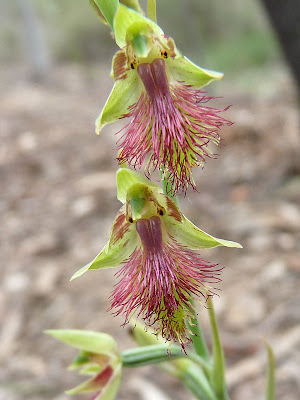This will be the last in this series, mostly because I'm heading off to Ecuador next week, and won't be back until early summer. For posting number 5 see here; further links to earlier ones can be found there. The main orchid season is winding down around Canberra, though there are still some nice ones around (and some still to come).
 |
| Mountain Beard Orchid, Calochilus montanus, Black Mountain. A striking and and uncommon orchid which may also be found in the ranges, up to about 1000 metres above sea level. |
A much commoner one is the Slender Sun Orchid; last time I featured a rare pink version, but here's the 'standard' form.
 |
| Thelymitra pauciflora, Black Mountain. |
Another uncommon one locally is a widespread shrub, Kangaroo Apple; the flowers tell us immediately that it is closely related to tomatoes, potatoes etc in the family Solanaceae.
 |
| Solanum linearifolium, Black Mountain. |
Finally Ivy Goodenia is an attractive little ground cover which can be found from local forests to the high mountains. The person it was named for - the Reverend Samuel Goodenough, Bishop of Carlisle - warrants his own story, and I shall oblige in due course.
 |
| Goodenia hederacea, Black Mountain. |



2 comments:
The Mountain Beard Orchid is so lovely. We have lots of Hibbertias and Goodenias out around southern NSW too, but it has got a bit dry for the orchids and there are not many about.
Thanks Madoqua. As I may have mentioned before, the beard orchids are a sort of totem of mine - sadly I find it more necessary to look for Grey Beard Orchids these days...
Post a Comment